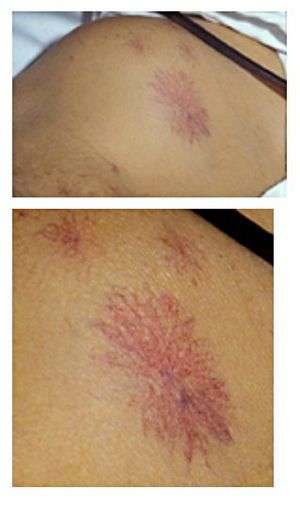Spider angioma
| Spider angioma | |
|---|---|
 | |
| Spider nevus | |
| Classification and external resources | |
| Specialty | dentistry |
| ICD-10 | I78.1 (ILDS I78.11) |
| ICD-9-CM | 448.1 |
| DiseasesDB | 12302 |
| MedlinePlus | 001095 |
| eMedicine | derm/293 |
A spider angioma (also known as a nevus araneus, spider nevus, vascular spider, and spider telangiectasia[1]) is a type of telangiectasis[2] (swollen blood vessels) found slightly beneath the skin surface, often containing a central red spot and reddish extensions which radiate outwards like a spider's web. They are common and may be benign, presenting in around 10–15% of healthy adults and young children.[3] However, having more than three spider angiomas is likely to be abnormal and may be a sign of liver disease. It also suggests the probability of esophageal varices.[4]
Distribution
Spider angiomas are found only in the distribution of the superior vena cava, and are thus commonly found on the face, neck, upper part of the trunk, and arms. They may also be present on the backs of the hands and fingers in young children.
Cause
Spider angiomas form due to failure of the sphincteric muscle surrounding a cutaneous arteriole. The central red dot is the dilated arteriole and the red "spider legs" are small veins carrying away the freely flowing blood. If momentary pressure is applied, it is possible to see the emptied veins refilling from the centre. No other angiomas show this phenomenon.
The dilation, in turn, is caused by increased estrogen levels in the blood. Many pregnant women, or women using hormonal contraception, have spider angiomas, due to high estrogen levels in their blood. Individuals with significant hepatic disease also show many spider angiomas, as their liver cannot metabolize circulating estrogens, specifically estrone, which derives from the androgen androstenedione.[3] About 33% of patients with cirrhosis have spider angiomas.[5] As such, microhemorrhages may be observed as spider angiomas.
Treatment
Spider angiomas are asymptomatic and usually resolve spontaneously. This is common in the case of children, although they may take several years to disappear. If the spider angiomas are associated with pregnancy, they may resolve after childbirth. In women taking oral contraceptives, they may resolve after stopping these contraceptives. The spider angiomas associated with liver disease may resolve when liver function increases or when a liver transplant is performed.
For spider angiomas on the face, techniques such as electrodesiccation and laser treatment can be used to remove the lesion.[6] There is a small risk of a scar, although the results are generally good. Spider angiomas can recur after treatment.
See also
References
- ↑ Rapini, Ronald P.; Bolognia, Jean L.; Jorizzo, Joseph L. (2007). Dermatology: 2-Volume Set. St. Louis: Mosby. pp. 1621–22. ISBN 1-4160-2999-0.
- ↑ "spider angioma" at Dorland's Medical Dictionary
- 1 2 Nevus Araneus at eMedicine
- ↑ http://jama.jamanetwork.com/article.aspx?articleid=1355997
- ↑ Li CP, Lee FY, Hwang SJ, et al. (1999). "Spider angiomas in patients with liver cirrhosis: role of alcoholism and impaired liver function". Scand. J. Gastroenterol. 34 (5): 520–3. doi:10.1080/003655299750026272. PMID 10423070.
- ↑ Geronemus, R. G. (1991). "Treatment of spider telangiectases in children using the flashlamp-pumped pulsed dye laser". Pediatr Dermatol. 8 (1): 61–3. doi:10.1111/j.1525-1470.1991.tb00843.x. PMID 1862028.